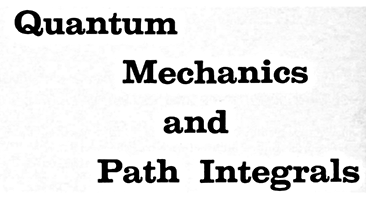
\(\)
Problem 8-7
It is believed that neutral particles of spin zero (like neutral pions) can, when free, be represented by a field \(\def\mb#1{\mathbf{#1}}\phi\) with a lagrangian
\begin{equation}
\def\ppdiff#1#2{\frac{\partial #1}{\partial #2}}
L=\int \mathscr{L}\,d^{3}\mb{r}=\int \frac{1}{2}\left[\left(\ppdiff{\phi}{t}\right)^{2}-c^{2}\big|\nabla \phi\big|^{2}-\frac{\mu^{2}c^{2}}{\hbar^{2}}\phi\right] \,d^{3}\mb{r}
\tag{8-133}
\end{equation}
\def\ppdiff#1#2{\frac{\partial #1}{\partial #2}}
L=\int \mathscr{L}\,d^{3}\mb{r}=\int \frac{1}{2}\left[\left(\ppdiff{\phi}{t}\right)^{2}-c^{2}\big|\nabla \phi\big|^{2}-\frac{\mu^{2}c^{2}}{\hbar^{2}}\phi\right] \,d^{3}\mb{r}
\tag{8-133}
\end{equation}
where \(\mu\) is some constant. Show that this field has quantized states corresponding to waves \(\exp(i\mb{k}\cdot\mb{r})\), where the energy of exitation is
\begin{equation}
\def\pdiff#1{\frac{\partial}{\partial #1}}
\def\reverse#1{\frac{1}{#1}}
\def\Bpdiff#1{\frac{\partial^{2}}{\partial #1^{2}}}
\def\Bppdiff#1#2{\frac{\partial^{2} #1}{\partial #2^{2}}}
\hbar\omega = \sqrt{\hbar^{2} k^{2}c^{2}+\mu^{2}c^{4}}
\tag{8-134}
\end{equation}
\def\pdiff#1{\frac{\partial}{\partial #1}}
\def\reverse#1{\frac{1}{#1}}
\def\Bpdiff#1{\frac{\partial^{2}}{\partial #1^{2}}}
\def\Bppdiff#1#2{\frac{\partial^{2} #1}{\partial #2^{2}}}
\hbar\omega = \sqrt{\hbar^{2} k^{2}c^{2}+\mu^{2}c^{4}}
\tag{8-134}
\end{equation}
If \(\hbar\mb{k}=\mb{p}\) is considered as the momentum of each excitation the energy is
\begin{equation}
E=\sqrt{|\mb{p}|^{2}c^{2}+\mu^{2}c^{4}}
\tag{8-135}
\end{equation}
E=\sqrt{|\mb{p}|^{2}c^{2}+\mu^{2}c^{4}}
\tag{8-135}
\end{equation}
This is the relativistic formula for the energy of a particle of momentum \(\mb{p}\) and mass \(\mu\).
( Note ) : For \(p^{2}\) small it is approximately the rest energy \(\mu c^{2}\) plus the kinetic energy \(p^{2}/2\mu\),
\[\displaystyle{E=\mu c^{2}+ \frac{p^{2}}{2\mu} + \dotsb}\]
( 解答 ) 前述したブログ記事の式 (2.16) から, 実数の場 \(\phi\) の運動方程式すなわち「オイラー=ラグランジュ方程式」は次となる:
\begin{align}
\ppdiff{\mathscr{L}}{\phi}-\pdiff{x^{\alpha}}\left(\ppdiff{\mathscr{L}}{\phi_{,\alpha}}\right)&=
\ppdiff{\mathscr{L}}{\phi}-\pdiff{t}\left(\ppdiff{\mathscr{L}}{(\partial\phi/\partial t)}\right)-\sum_{k=1}^{3}\pdiff{x_k}\left(\ppdiff{\mathscr{L}}{(\partial\phi/\partial x_k)}\right)\notag\\
&=\ppdiff{\mathscr{L}}{\phi}-\pdiff{t}\left(\ppdiff{\mathscr{L}}{(\partial\phi/\partial t)}\right)
-\nabla\cdot\left(\ppdiff{\mathscr{L}}{(\nabla\phi)}\right)=0
\tag{1}
\end{align}
\ppdiff{\mathscr{L}}{\phi}-\pdiff{x^{\alpha}}\left(\ppdiff{\mathscr{L}}{\phi_{,\alpha}}\right)&=
\ppdiff{\mathscr{L}}{\phi}-\pdiff{t}\left(\ppdiff{\mathscr{L}}{(\partial\phi/\partial t)}\right)-\sum_{k=1}^{3}\pdiff{x_k}\left(\ppdiff{\mathscr{L}}{(\partial\phi/\partial x_k)}\right)\notag\\
&=\ppdiff{\mathscr{L}}{\phi}-\pdiff{t}\left(\ppdiff{\mathscr{L}}{(\partial\phi/\partial t)}\right)
-\nabla\cdot\left(\ppdiff{\mathscr{L}}{(\nabla\phi)}\right)=0
\tag{1}
\end{align}
問題文中の式 (8-133) から, このときのラグランジアン密度 \(\mathscr{L}\) は,
\begin{equation}
\mathscr{L}=\reverse{2}\left[\left(\ppdiff{\phi}{t}\right)^{2}-c^{2}\left|\nabla\phi\right|^{2}
-\frac{\mu^{2}c^{4}}{\hbar^{2}}\phi^{2}\right]
\tag{2}
\end{equation}
\mathscr{L}=\reverse{2}\left[\left(\ppdiff{\phi}{t}\right)^{2}-c^{2}\left|\nabla\phi\right|^{2}
-\frac{\mu^{2}c^{4}}{\hbar^{2}}\phi^{2}\right]
\tag{2}
\end{equation}
従って,
\begin{align}
&\ppdiff{\mathscr{L}}{(\nabla\phi)}=-\frac{c^{2}}{2}\cdot 2\nabla\phi=-c^{2}\nabla\phi,\quad
\ppdiff{\mathscr{L}}{(\partial\phi/\partial t)}=\reverse{2}\cdot2\ppdiff{\phi}{t}=\ppdiff{\phi}{t},\quad
\ppdiff{\mathscr{L}}{\phi}=-\frac{\mu^{2}c^{4}}{\hbar^{2}}\phi
\tag{3}
\end{align}
&\ppdiff{\mathscr{L}}{(\nabla\phi)}=-\frac{c^{2}}{2}\cdot 2\nabla\phi=-c^{2}\nabla\phi,\quad
\ppdiff{\mathscr{L}}{(\partial\phi/\partial t)}=\reverse{2}\cdot2\ppdiff{\phi}{t}=\ppdiff{\phi}{t},\quad
\ppdiff{\mathscr{L}}{\phi}=-\frac{\mu^{2}c^{4}}{\hbar^{2}}\phi
\tag{3}
\end{align}
式 (3) の各々を式 (1) に代入すると, 次の微分方程式が得られる:
\begin{align}
&\ppdiff{\mathscr{L}}{\phi}-\pdiff{t}\left(\ppdiff{\mathscr{L}}{(\partial\phi/\partial t)}\right)
-\nabla\cdot\left(\ppdiff{\mathscr{L}}{(\nabla\phi)}\right)
=-\frac{\mu^{2}c^{4}}{\hbar^{2}}\phi-\pdiff{t}\left(\ppdiff{\phi}{t}\right)-\nabla\cdot\big(-c^{2}\nabla\phi\big)=0\notag\\
\therefore&\quad \Bppdiff{\phi}{t}-c^{2}\nabla\cdot\nabla \phi+\left(\frac{\mu c^{2}}{\hbar}\right)^{2}\phi=0
\tag{4}
\end{align}
&\ppdiff{\mathscr{L}}{\phi}-\pdiff{t}\left(\ppdiff{\mathscr{L}}{(\partial\phi/\partial t)}\right)
-\nabla\cdot\left(\ppdiff{\mathscr{L}}{(\nabla\phi)}\right)
=-\frac{\mu^{2}c^{4}}{\hbar^{2}}\phi-\pdiff{t}\left(\ppdiff{\phi}{t}\right)-\nabla\cdot\big(-c^{2}\nabla\phi\big)=0\notag\\
\therefore&\quad \Bppdiff{\phi}{t}-c^{2}\nabla\cdot\nabla \phi+\left(\frac{\mu c^{2}}{\hbar}\right)^{2}\phi=0
\tag{4}
\end{align}
結果式の両辺を \(c^{2}\) で割り算すると, これは Klein-Gordon 方程式になっている:
\begin{equation}
\reverse{c^{2}}\Bppdiff{\phi}{t}-\nabla^{2}\phi+\left(\frac{\mu c}{\hbar}\right)^{2}\phi
=\big(\square +\mu’^{2}\big)\phi=0,\quad \mu’=\frac{\mu c}{\hbar}
\tag{5}
\end{equation}
\reverse{c^{2}}\Bppdiff{\phi}{t}-\nabla^{2}\phi+\left(\frac{\mu c}{\hbar}\right)^{2}\phi
=\big(\square +\mu’^{2}\big)\phi=0,\quad \mu’=\frac{\mu c}{\hbar}
\tag{5}
\end{equation}
定数 \(\mu’=\mu c/\hbar\) は,「長さの次元」を持っている.また, 演算子 \(\square\) は「D’Alembertian」と呼ばれている. J.J.Sakurai によれば, この式 (5) は「1920年代の半ばに, 自由粒子に対する “非相対論的な” Schrödinger方程式に対応する”相対論的な”波動方程式の候補として, O.Klein と W.Gordon だけでなく E. Schorödinger も考えた式である」.式 (5) を質量 \(\mu\) の自由粒子に関する相対論的なエネルギー=運動量の関係:
\begin{equation}
E^{2}=\mu^{2}c^{4}+c^{2}\mb{p}^{2}
\tag{6}
\end{equation}
E^{2}=\mu^{2}c^{4}+c^{2}\mb{p}^{2}
\tag{6}
\end{equation}
と比較すると, 初等的な量子化の規則,
\begin{equation}
E\to i\hbar\pdiff{t},\quad \mb{p}\to -i\hbar\nabla
\tag{7}
\end{equation}
E\to i\hbar\pdiff{t},\quad \mb{p}\to -i\hbar\nabla
\tag{7}
\end{equation}
によって両者が対応していることは明らかである.
そこで, 次の “非相対論的な” Schrödinger方程式に対する初等的な自由粒子解
\begin{equation}
\phi(\mb{r},t)=e^{-iE t/\hbar}\psi_0(\mb{r}),\quad \psi_0(\mb{r})=A\,\exp\left(i\mb{k}\cdot\mb{r}\right),\quad E=\hbar\omega
\tag{8}
\end{equation}
\phi(\mb{r},t)=e^{-iE t/\hbar}\psi_0(\mb{r}),\quad \psi_0(\mb{r})=A\,\exp\left(i\mb{k}\cdot\mb{r}\right),\quad E=\hbar\omega
\tag{8}
\end{equation}
が, 式 (4) 即ち式 (5) を満たしているかを実際に代入して確認してみよう.まず,
\begin{align}
&\ppdiff{\phi}{t}=-\frac{iE}{\hbar}\phi,\qquad \Bppdiff{\phi}{t}=\left(-\frac{iE}{\hbar}\right)^{2}\phi=-\frac{E^{2}}{\hbar^{2}}\phi,\notag\\
&\nabla\phi=e^{-iEt/\hbar}\nabla\psi_0(\mb{r})=e^{-iEt/\hbar}i\mb{k}\psi_0(\mb{r})=i\mb{k}\phi,\notag\\
&\nabla\cdot\nabla\phi= (i\mb{k})^{2}\phi= -\mb{k}^{2}\phi,
\tag{9}
\end{align}
&\ppdiff{\phi}{t}=-\frac{iE}{\hbar}\phi,\qquad \Bppdiff{\phi}{t}=\left(-\frac{iE}{\hbar}\right)^{2}\phi=-\frac{E^{2}}{\hbar^{2}}\phi,\notag\\
&\nabla\phi=e^{-iEt/\hbar}\nabla\psi_0(\mb{r})=e^{-iEt/\hbar}i\mb{k}\psi_0(\mb{r})=i\mb{k}\phi,\notag\\
&\nabla\cdot\nabla\phi= (i\mb{k})^{2}\phi= -\mb{k}^{2}\phi,
\tag{9}
\end{align}
これらを式 (4) に代入すると,
\begin{align}
\Bppdiff{\phi}{t}-c^{2}\nabla\cdot\nabla \phi+\left(\frac{\mu c^{2}}{\hbar}\right)^{2}\phi
&=-\frac{E^{2}}{\hbar^{2}}\phi+c^{2}\mb{k}^{2}\phi +\left(\frac{\mu c^{2}}{\hbar}\right)^{2}\phi \notag\\
&=\left[-\frac{E^{2}}{\hbar^{2}}+c^{2}\mb{k}^{2}+\left(\frac{\mu c^{2}}{\hbar}\right)^{2}\right]\phi=0
\tag{10}
\end{align}
\Bppdiff{\phi}{t}-c^{2}\nabla\cdot\nabla \phi+\left(\frac{\mu c^{2}}{\hbar}\right)^{2}\phi
&=-\frac{E^{2}}{\hbar^{2}}\phi+c^{2}\mb{k}^{2}\phi +\left(\frac{\mu c^{2}}{\hbar}\right)^{2}\phi \notag\\
&=\left[-\frac{E^{2}}{\hbar^{2}}+c^{2}\mb{k}^{2}+\left(\frac{\mu c^{2}}{\hbar}\right)^{2}\right]\phi=0
\tag{10}
\end{align}
この \([\,]\) 内はゼロとなるべきであるから,
\begin{align}
-\frac{E^{2}}{\hbar^{2}}+c^{2}\mb{k}^{2}+\frac{\mu^{2} c^{4}}{\hbar^{2}}=0\quad \therefore\quad
E^{2}&=c^{2}\hbar^{2}\mb{k}^{2}+\mu^{2}c^{4}\tag{11}\\
\rightarrow\quad E=\hbar\omega&=\sqrt{c^{2}\hbar^{2}\mb{k}^{2}+\mu^{2}c^{4}}
\tag{12}
\end{align}
-\frac{E^{2}}{\hbar^{2}}+c^{2}\mb{k}^{2}+\frac{\mu^{2} c^{4}}{\hbar^{2}}=0\quad \therefore\quad
E^{2}&=c^{2}\hbar^{2}\mb{k}^{2}+\mu^{2}c^{4}\tag{11}\\
\rightarrow\quad E=\hbar\omega&=\sqrt{c^{2}\hbar^{2}\mb{k}^{2}+\mu^{2}c^{4}}
\tag{12}
\end{align}
自由粒子の運動量についての式 \(\mb{p}=\hbar\mb{k}\) を用いれば, この結果は自由粒子の「相対論的なエネルギー=運動量の関係式」(6) に一致する.従って,「場 \(\phi\) は, 波動 \(e^{i\mb{k}\cdot\mb{r}}\) に相当する量子状態 \(\psi(\mb{r},t)=A\exp(i\mb{k}\cdot\mb{r}-i\omega t)\) を有している」ことが示された.

